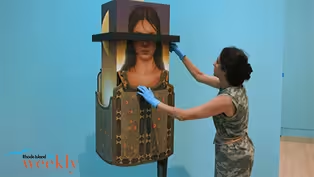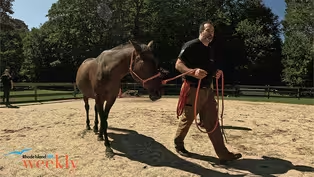
Our Heritage
Clip: Season 4 Episode 40 | 9m 30sVideo has Closed Captions
Three Rhode Island Latinos share how their heritage influences their art and music.
The Hispanic population in Rhode Island has more than doubled since 2000. In celebration of Hispanic Heritage Month, Rhode Island PBS Weekly highlights three local Latinos who’ve made their mark in the local art and music scene.
Problems playing video? | Closed Captioning Feedback
Problems playing video? | Closed Captioning Feedback
Rhode Island PBS Weekly is a local public television program presented by Ocean State Media

Our Heritage
Clip: Season 4 Episode 40 | 9m 30sVideo has Closed Captions
The Hispanic population in Rhode Island has more than doubled since 2000. In celebration of Hispanic Heritage Month, Rhode Island PBS Weekly highlights three local Latinos who’ve made their mark in the local art and music scene.
Problems playing video? | Closed Captioning Feedback
How to Watch Rhode Island PBS Weekly
Rhode Island PBS Weekly is available to stream on pbs.org and the free PBS App, available on iPhone, Apple TV, Android TV, Android smartphones, Amazon Fire TV, Amazon Fire Tablet, Roku, Samsung Smart TV, and Vizio.
Providing Support for PBS.org
Learn Moreabout PBS online sponsorship- There were times when I also couldn't like really find words, so I would just, or I'm not even sure what's bothering me, so I'll just paint.
- [Michelle] For artist Tamara Diaz, painting has offered a window to her soul.
- I don't know what I'm doing till it's done.
And then it tells me how I'm feeling.
Like instead of my feelings guiding it, it's almost like it gives me the insight as to like, oh wow, this is what's going on.
Like it gives me insight to my own self.
- [Michelle] She describes her designs as pop art with a tropical twist.
Her bold colors often depict difficult moments.
Born in New York to a father who fled the Cuban Revolution, Diaz says some of her best creations come from pain including this one, mi Cuba linda, lloro por ti, which means my beautiful Cuba, I cry for you.
- Even though we're not there in our homeland, it's something that we carry with us every day.
It's basically in your soul, it's kind of complicated to like be able to express those emotions on a regular basis.
So sometimes it just comes out in my art.
- [Michelle] Diaz has made two trips to the island.
She says it's easy to fall in love with the Cuban people and the culture.
- I basically had that feeling my whole life like I'll never be complete until I get to Cuba.
And so it was like such a big moment for me to set my foot down on the Cuban soil.
- Diaz is the descendant of survivors.
Not only did her father and his family leave Cuba soon after Fidel Castro took power, but her mother's parents also faced persecution, they're Holocaust survivors.
How does being the descendant of survivors manifest itself in your artwork?
- I mean, I think there is like that generational trauma that gets passed down of people having to leave their country, leaving with nothing, all of those kinds of things, that's very like emotional.
But you know, it comes out in my artwork because it does affect me even when I don't know it.
- [Michelle] Her art adorns the walls of her Providence home where she showcases her interest in spirituality and cultures.
She showed us a painting depicting The Last Supper.
- As you can see in the middle, I have a menorah so it kinda like has that element of Judaism.
But we also have like (speaks in foreign language), we have Domino's, some peace cookies and the palm tree is always symbolizing like Cuba or my roots.
- [Michelle] For Diaz, one of the best parts of painting is sharing her love of art with others.
She's a licensed, independent clinical social worker and encourages children to illustrate their emotions.
- You can have someone draw or paint how they're feeling when they can't really have the words to express it.
(bright traditional music) - For Jesus Andujar, music is his form of expression.
- And when I come home from work, even no matter how tired I am, I have to sit down the drum and play a little bit.
- What goes through your mind as you're playing?
- [Jesus] Music, I forgot about everything.
Every negative thing that happened during the day.
(bright traditional music) - [Michelle] Andujar has been playing Afro percussion music for four decades.
On this early evening in September, he's performing at a festival in Providence with his band, Grupo Sazon.
(bright traditional music) He knows how to work the crowd.
Growing up in the Dominican Republic, he didn't always have his eyes set on performing but he discovered music was in his blood.
- I never thought that I wanna be a musician.
And then at some point, I went to live with one of my uncles and he was a farmer.
So he introduced me to be a farmer and a lot of things that we used to do in the farm was music related.
- Andujar remembers harvesting rice on the island.
A process he says required rhythm and coordination.
(bright traditional music) It wasn't long before he realized all that farm work was developing his love for music.
He showed us some of the many instruments he's mastered from his studio in Providence.
(bright drum music) From the Dominican drum (bright drum music) to the conga (bright drum music) and the cajon.
(bright drum music) He says his big break came when he moved to New York in the 80s and joined the band La Gran Manzana.
(bright traditional music) Touring with the band was his ticket to seeing the world.
He then moved to Rhode Island in the late 90s.
(bright traditional music) 25 years later, Andujar made a name for himself in Rhode Island performing for large crowds at WaterFire.
What is that feeling like to be on a stage?
You have thousands of people watching you.
You're in your zone, what is that adrenaline rush like?
- It's such a great feeling and also I like when you see people dancing while you play, this like energy exchange, the more energy you get to the people, you get that back to you.
- That energy exchange has pushed artist Angela Gonzalez better known as Agonza out of her comfort zone.
- I didn't expect people to like fall that in love with my pieces.
Organically, it just happens.
- [Michelle] Agonza describes her style as Afro-Latina surrealism.
She has a studio in Providence but says getting here, was a painful journey.
She grew up in an abusive environment with relatives who were in and out of prison.
- For a while, I was just like walking around with that pain.
Nobody ever taught me how to deal with that.
So my form was my art, I just doodled.
- [Michelle] When she was nine, she moved to the Dominican Republic to live with her great-grandmother who had no running water or electricity.
Not long after she died, Agonza so went to live in an orphanage.
I think it's fair to say you did not have an easy childhood?
- I think as an adult I see it differently but I think my mom and my dad had me way too early.
They were too young.
And so my mom didn't know how to be a mom and my dad just didn't know how to be a dad.
- [Michelle] When Agonza was 17, her stepmother who had adopted her brought her back to the ocean state.
She went on to study at the University of Rhode Island.
That's where she met Professor Bob Dillworth who she says altered the course of her life.
- I got into one of his classes and he believes that bigger is better.
So he, instead of giving us these like regularized canvases, he would hire a model to model for us nude, to get the structure of the like bodies.
And I refused to paint like a thinner woman, and I was just like, "No, I'm not gonna paint a thinner woman, "like that's just not what I look like."
- [Michelle] These days, Agonza can hardly keep track of how many walls she's been asked to paint.
But this one in North Providence hits close to home.
- I always get emotional with this piece because it's very, it's very personal, so, sorry.
- [Michelle] She designed this mural outside of St. Mary's Home for Children, a nonprofit agency that works with some of Rhode Island's most vulnerable children.
Agonza says she sees herself in them.
- Because if I was to see this as a little girl, I would've been like, you know there wasn't things like this or people who look like me.
So for me to be that person for kids to look at, it feels good.
- [Michelle] Agonza hopes the children who see this are left inspired.
She echoes to them the words her former professor shared with her.
- Like I tell them, just dream big.
Like Bob told me always just go big or go home.
(soft upbeat music)
Video has Closed Captions
Clip: S4 Ep40 | 9m 50s | Iranian-born artist puts the oppression of women at the center of her art. (9m 50s)
Video has Closed Captions
Clip: S4 Ep40 | 9m 2s | Visit a farm program for veterans suffering from PTSD that offers healing through horses. (9m 2s)
Providing Support for PBS.org
Learn Moreabout PBS online sponsorship
- News and Public Affairs

Top journalists deliver compelling original analysis of the hour's headlines.

- News and Public Affairs

FRONTLINE is investigative journalism that questions, explains and changes our world.












Support for PBS provided by:
Rhode Island PBS Weekly is a local public television program presented by Ocean State Media

